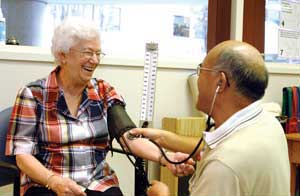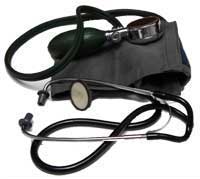Completion requirements
View
Topic Overview

- Postural or orthostatic hypotension is a significant fall in blood pressure that occurs when a person stands up or is in an upright position.
- Dizziness, light headedness, blurred vision, loss of consciousness, and falls are the common symptoms.
- Treatment of postural hypotension depends on the cause.
- There are many ways to avoid or reduce postural hypotension.
Introduction

- Postural or orthostatic hypotension is a significant fall in blood pressure that occurs when a person stands up or is in an upright position.
- It results in dizziness, light headedness, blurred vision, loss of consciousness, and falls.
- It is estimated that one-third of older people living in the community and one-half of those in the hospital or in nursing homes are affected by this condition.
What You Need to Know
Blood Pressure

- Your blood pressure changes when you change position.
- When your heart contracts, it pushes blood into the arteries causing an increase in blood pressure (systolic pressure). When your heart relaxes and refills with blood, the pressure in the arteries decreases (diastolic pressure).
- Standing causes 500 to 700 ml of blood to pool in the legs, so there is less blood for the heart to pump. This results in a decrease in blood pressure.
- Special cells called baroreceptors (located close to the neck arteries) sense this decrease in blood pressure. They counteract by triggering the heart to beat faster and pump more blood in order to stabilize the blood pressure.
Orthostatic Hypotension
- Normally, the blood pressure response that occurs when an individual moves to a standing position is a small reduction in systolic blood pressure and a small increase in diastolic blood pressure (the two numbers that are measured). This imbalance lasts only for a few seconds as it adjusts to the new posture.
- Postural hypotension occurs when there is a significant decrease in the systolic and/or diastolic blood pressure when a person stands up. It usually occurs within three minutes of standing. Occassionally, people experience this after standing for 5 or more minutes. It is caused by abnormal blood pressure regulation and becomes more common with aging.
Symptoms
 Symptoms of orthostatic (postural) hypotension include:
Symptoms of orthostatic (postural) hypotension include:
- The most common symptom is feeling light-headed or dizzy after standing up from a lying or sitting position. This usually lasts from a few seconds to minutes.
- Other symptoms include blurring of vision, loss of consciousness (syncope, fainting), and falls.
Causes
Causes of postural hypotension include:
- inadequate fluid intake or dehydration
- prolonged bed rest or deconditioning
- diabetes, Parkinson's disease
- heart failure or chronic kidney failure
- medications
- poorly controlled hypertension
Prevention
 To prevent postural hypotension:
To prevent postural hypotension:
- Drink enough fluids (1.5 – 2 litres or 6 – 8 glasses per day) to avoid dehydration.
- Have the health care provider review medications to identify any that can cause postural hypotension.
- When waking up in the morning, sit on the edge of the bed and do calf muscle exercises for 5 minutes before standing.
- Avoid quick position (postural) changes.
- If symptoms appear, sit down quickly and wait for them to subside.
- Postural hypotension tends to be worse in the morning, so plan activities for the afternoon or later in the day.
- Avoid prolonged standing, hot environments, and excessive alcohol use.
- Raise the head end of the bed to 15 to 20 degrees.
- Compression stockings that are applied up to thigh level may help to decrease the pooling of blood in the leg veins. Stockings should be measured by a health professional to ensure need and appropriate fit.
- Some people experience postural hypotension after meals. This is called post-prandial hypotension. If you have this, stay sitting for 30 minutes after eating.
When to Seek Medical Advice
If postural hypotension occurs, your family member should see their health care provider for medical advice to avoid complications like loss of consciousness and falls and to identify any underlying problems.
Helpful Resources
- The Mayo Clinic's explanation of orthostatic hypotension is well-organized and complete. It includes signs and symptoms, causes, and self-care.
- Understanding Low Blood Pressure describes low blood pressure and discusses a number of causes.
- Overview of Low Blood Pressure in the Merck Manual Home Health Handbook discusses causes, symptoms and treatment.
Last modified: Wednesday, 27 April 2022, 8:11 AM